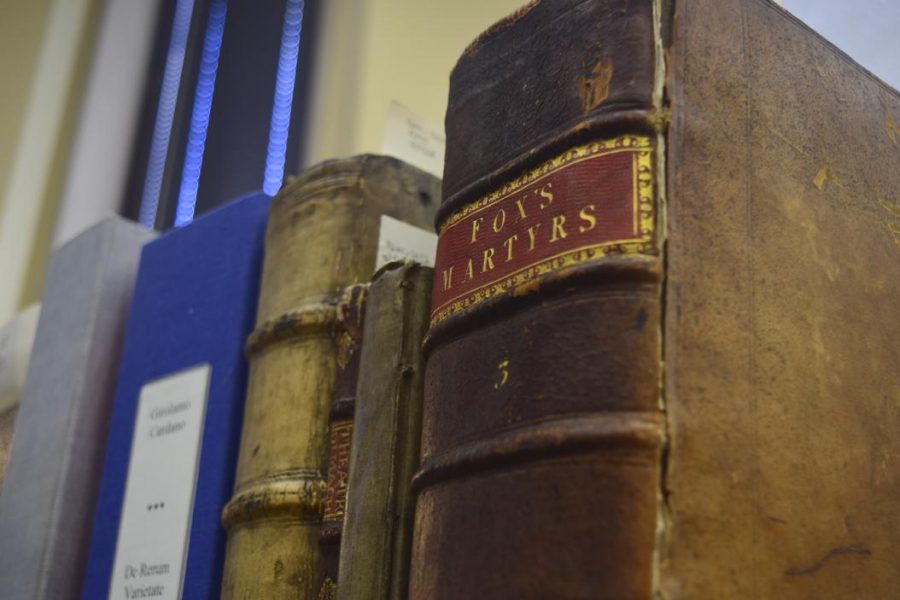A room tucked in a corner on the third floor of Hillman Library holds centuries of information nearly impossible to find anywhere else.
Hundreds of books line one of the walls, all neatly shelved with the occasional Post-it peeking out from between yellowed pages. The covers, in hues of brown, black and blue, contrast with the colorful glass lamp on the front desk. Warm orbs of light, placed strategically next to comfy reading couches, dot the room.
In other words, the collection room is a book lover’s paradise. But in an age where more and more students use Nooks and Kindles and download their books or entertainment from the internet, many students never step foot in the Special Collections department in Hillman Library.
“Those who do encounter the department at some point in their academic career often become frequent visitors,” Zach Grewe, a student employee in the department, said. “But there are many students who never discover the department simply because they never have a research project, class or assignment that forces them to stop by.”
In the department, librarians gather and organize books, essays and manuscripts from as far back as the 1400s. The department houses several collections such as the Nietz Old Textbook Collection, the Elizabeth Nesbitt Collection on 19th century children’s literature and the Curtis Theatre Collection from the early 20th century. Students from local universities, such as Carnegie Mellon University and Point Park University, often come in to peruse the collections.
According to Jeanann Haas, the head of the department, the collection had more than 500 visitors — 380 of which were undergraduate and graduate students — over the course of the last year. The department hosts about four class visits per month.
The department — founded in 1966 — works in conjunction with other campus libraries, including the Frick Fine Arts Library and the Archives Service Center.
Grewe, a senior majoring in psychology and gender studies, applied for a job in the Special Collections after winning an Archival Scholars Research Award this spring.
“My favorite thing about working in the department is the access I get to the collections,” Grewe said. “I’m currently working on a bibliography of radical underground newspapers and perusing the various publications has been of great interest to me as a student — but also, quite simply, a lot of fun.”
The collection can be a treasure hunt for those interested in digging up historic or glamorous memorabilia.
William Daw, the curator of the theater collection, found a sketch of Katharine Hepburn autographed by the actress in one of the Oliver P. Merriman scrapbooks.
One of the collection’s oldest materials is a manuscript from the mid-1400s discussing monastic life, written in Latin by three different scribes. The oldest printed artifact in the collection is a 15th century leaf — a single printed page — from the letters of St. Jerome, a Christian saint.
Daw said seeing and handling these materials firsthand is an incomparable experience, something that an online database can never match.
“I believe that the physical book still retains a lot of valuable context, even when its content is available online,” Daw said. “It seems to me that the researchers never regret taking the extra time to view the materials in our collection in person.”
Pitt’s budget for rare books differs each year, based on the University’s primary needs. Haas and her colleagues have conversations with faculty and researchers to plan their next acquisitions and try to pinpoint what is being used and what is needed.
“Our allocated budget is spent on purchasing rare book or manuscript materials that support the teaching and research endeavors at Pitt,” Haas said. “We try to develop strengths in combination of what is taught and supported at Pitt.”
The department purchases materials as they’re needed during the year. Administration consults a variety of book dealers that specialize in different areas of rare books and also use book dealers such as AbeBooks, according to Haas.
For security reasons, Haas withheld specific budget information.
The department also acquires materials from families that donate books passed through previous generations or found while spring cleaning. Haas tries to find the books a home, either at Hillman or at another library.
“If the gift doesn’t quite fit with what we’re collecting, we go through and try to see if it fits our collection. If it doesn’t, we put it on an exchange list with the other libraries,” Haas said.
Pitt’s University Library System is in charge of organizing the donations and is primarily interested in scholarly material or materials that can be added to one of the niche collections. If ULS can’t find a place for the book, it is either exchanged for another book from other libraries around the world, sold to raise revenue for new books or sent to other organizations or nonprofits, such as Better World Books.
All the behind-the-scenes work reaps rewards, Haas said, when students come in to ask for help.
“If a student has a research idea and wants materials, they can contact the Special Collections department,” she said. “That’s what librarians are here for. We’re here to save you time.”
Whether it’s discussing her love for the Atlas Coelestis — “a vibrant book about early astrology” — or planning the upcoming Audubon Day — when the department showcases John James Audubon’s rare bird prints — Haas views her job as bridging the gap between research and showcasing the Special Collection department’s innumerable materials and archives.
“It’s a place where we have the opportunity to promote things people have never seen up close,” Haas said. “It’s amazing.”



